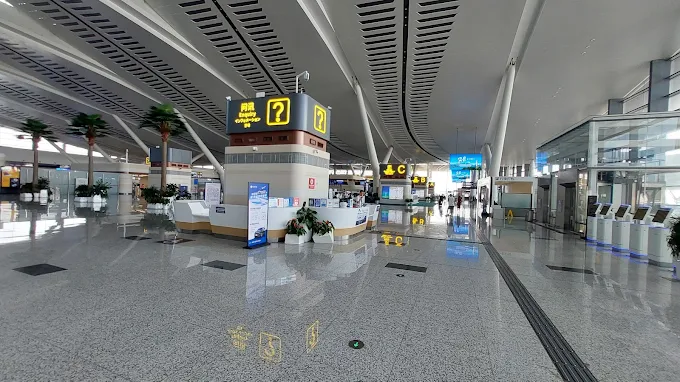Yantai Penglai International Airport Named World’s Most Beautiful Airport in 2025 – And It’s Not Singapore’s Changi
Each year, global awards honor not just efficiency and passenger satisfaction, but also beauty, innovation, and architectural brilliance. In 2025, the Prix Versailles, a prestigious international architecture prize, declared Yantai Penglai International Airport’s Terminal 2 in China as the world’s most beautiful airport—a surprise to many who expected Singapore’s iconic Changi Airport to retain its long-standing glory.
While Changi Airport continues to top rankings for customer experience, its absence from this year’s Prix Versailles list sparked conversations across the travel industry. Let’s take a closer look at what made Yantai stand out, how other airports performed, and why the definition of “best” depends heavily on what you’re measuring.
Yantai Penglai: A Design Masterpiece on China’s Coast
Located in eastern China’s Shandong Province, Yantai Penglai International Airport was originally opened in 2015 to serve the growing transportation needs of Yantai, a major port city with deep historical connections to maritime trade.
Terminal 2, now crowned the most beautiful airport building of 2025, showcases a bold and futuristic E-shaped layout designed to streamline both airside and landside operations. But functionality aside, the aesthetics are what truly set this terminal apart.
Explore More- Top 10 Busiest Airports in China: A Gateway to the World
The terminal features:
- A glass dome canopy that filters natural light through a massive multi-level atrium.
- Architectural elements inspired by ships and the sea, evoking the area’s maritime past and linking to the ancient Maritime Silk Road.
- Curved interiors, flowing lines, and a seamless blend between structure and nature.
The design promotes not only visual elegance but also environmental sustainability and energy efficiency—an increasingly important factor in modern architecture.
Prix Versailles: More Than Just Looks
The Prix Versailles is awarded by an independent jury affiliated with UNESCO and focuses on architectural beauty, cultural significance, and harmony with the environment. It’s not about terminals that are the busiest or most high-tech—it’s about celebrating global excellence in design across airports, hotels, shopping malls, and other commercial spaces.
The 2025 airport list highlighted six exceptional terminals from across the globe, chosen for their architectural innovation, sustainability, and aesthetic integration with their local environment.
Here are the other five finalists:
1. Marseille Provence Airport – Terminal 1 (France)
This terminal blends new construction with older 1960s architecture. Using recycled steel and timber, the space emphasizes modular design and sustainability. A towering 22-meter high hall serves as its centerpiece, filled with natural light and open space.
2. Roland Garros Airport – Arrivals Terminal (Réunion Island, France)
Located on a tropical island in the Indian Ocean, this terminal embraces bioclimatic design. Natural ventilation, adjustable shutters, and lush vegetation are integrated throughout to naturally cool the space, making air conditioning largely unnecessary.
Discover More- Top 10 Busiest Airports in France- A Detailed Analysis
3. Kansai International Airport – Terminal 1 (Japan)
This terminal, originally designed by legendary architect Renzo Piano, underwent a modern renovation that kept its signature style while enhancing comfort and efficiency. It uses natural materials, soft lighting, and wide corridors to reduce stress and improve passenger flow.
4. Portland International Airport – Main Terminal (USA)
One of the greenest airports in the U.S., Portland’s main terminal was redesigned using timber from Oregon forests, incorporating over 5,000 live plants and vast skylights. The theme: bringing the Pacific Northwest’s forests inside. It’s a perfect example of biophilic design.

5. San Francisco International Airport – Terminal 1 (USA)
Also known as the Harvey Milk Terminal, this terminal blends luxury with sustainability. It achieved a LEED Platinum certification, with a 58% reduction in energy usage and 79% drop in carbon emissions compared to older buildings. It’s also home to the only accredited airport museum in the world.
Discover More- The Top 10 Busiest Airports in the United States in 2024
Why Changi Didn’t Make This List
Despite its continued global admiration, Singapore Changi Airport was not featured in the Prix Versailles list this year. However, it hasn’t lost its shine.
In April 2025, Skytrax named Changi the World’s Best Airport for a record-breaking 13th time. It also secured awards for best airport dining, cleanest airport washrooms, and top airport in Asia. The criteria for Skytrax rankings are different—they focus on customer satisfaction, cleanliness, service quality, and amenities.
Moreover, Travel + Leisure ranked Changi second in its annual World’s Best Airports list, just behind Istanbul Airport. Features like the Rain Vortex indoor waterfall, butterfly garden, and entertainment zones continue to make Changi a global favorite.
What Makes an Airport “The Best”?
The key to understanding these differing rankings lies in how “best” is defined:
| Award Body | Focus Area | 2025 Winner |
|---|---|---|
| Prix Versailles | Architecture & Design | Yantai Penglai Int’l Airport (China) |
| Skytrax | Passenger Experience & Amenities | Singapore Changi Airport |
| Travel + Leisure | Reader Preferences & Comfort | Istanbul Airport (Turkey) |
In essence:
- If you’re judging design and aesthetics, Yantai leads.
- For comfort and experience, Changi still reigns.
- For modern mega-hub appeal, Istanbul is catching global attention.
Final Thoughts
The crown for the world’s most beautiful airport in 2025 may have shifted from the usual favorites to a lesser-known gem in China—but it highlights the growing importance of architecture, sustainability, and cultural identity in airport design.
Yantai Penglai’s win is a reminder that airports today are more than just transit hubs. They’re symbols of national pride, gateways to culture, and increasingly, works of art in their own right.
As airports around the world race to upgrade both style and substance, one thing is clear: beauty can fly just as high as function.